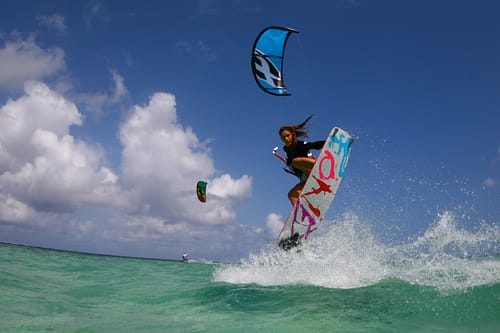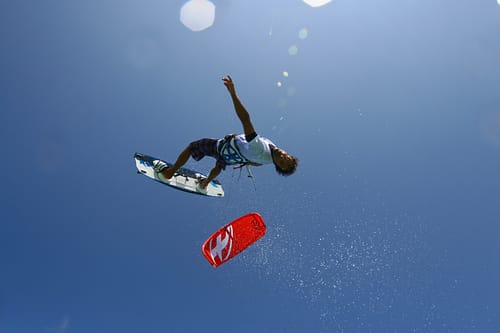Source: SBC Kiteboarding
Mar 28, 2014
Raphaël Salles is the owner and driving force behind F-One Kiteboarding. F-One has been a leader in kiteboarding R&D since 1997 when F-One became the first company to sell production kiteboards. The F-One Bandit 7 recently won SBC Kiteboard test team award for most versatile all-terrain kite. Salles answers questions about the new F-One Bandit 7.
What steps were taken to develop the new bandit? After six years of development, how do you keep redesigning and developing the flagship product of F-ONE?
Raphaël Salles: We worked on multiple axes: the bandit has been evolving since the first model through constant redesign. After many years of reworking and evolving the original product, it was time for a new approach. The bandit needed a new platform, a complete rethinking of our flagship product to keep it at the forefront of kitesurfing. Robert GRAHAM our new kite designer brought in a new vision and options to help us make the bandit better especially in the high-end. It is more stable, while remaining very precise with a direct feeling in the bar. The key evolution was a new fabric: we introduced the TECHNOFORCE™ double ripstop from TEIJIN.What did Robert Graham bring to F-ONE? How were you able to work so well together, having known each other such a short time?
It was definitely taking a risk to bring a new designer after so many years, but sometimes you need a new approach to keep moving forward. Robert GRAHAM has extensive experience in paragliding and kite design. He is extremely meticulous in his design work and testing. His passion for designing and his ability to analyze the behaviors of the kites have helped us explore new options and discover new approaches to solving problems. Much like myself he believes in the constant progression and evolution of our products through extensive prototype testing. He worked on every kite size to constantly bring the best aspect ratio to each size so that the whole line will be homogenous.What flying characteristics will we discover when we fly the new BANDIT? The first thing we increased was the wind range of the kites. While keeping its legendary early planning characteristic the high-end control was greatly increased. With Mika we started by testing the 9 m² and were surprised at the end of the day to check the wind readings up into the 30 knots range while it felt like it had blown 25 knots all day. We even tested it in up to 45 knots without realizing that the wind was that strong.
The new BANDIT has less lateral pull, the most negative traction for a kite surfer because it pulls you sideways off your edge. By simply improving the stability on the side of the window, the kite gives you a steadier pull with less twitching and jerking.
This means that the bandit benefits from a larger wind range with smooth and constant depower. The reduced lateral pull allows the rider to go upwind more effectively.
The maneuverability and fluidity of all turns in the kite, including kiteloops, are at the same time impressive in their smoothness and in the power delivered when needed.
Jumping: sending the kite to 12 o’clock is made easier due to its reduced lateral pull and increased maneuverability. Loading up is made easier by the direct steering. A lot of work went into the aerodynamic properties of the kite to make sure the kite sends you high with a good hang time, which will allow the rider to avoid those long but low jumps.What sensations will the Bandit deliver to a rider?
The bar of the new BANDIT will deliver great sensations through its direct steering and control. It was reworked to deliver maximum sensations to the rider. The entire kite feels very solid when it flies, with very little deformation and fluttering in the canopy. The bar sensation is firm but not heavy and all commands and feedback are direct between the rider in the kite. The BANDIT will deliver unmatched levels of control and precision in your flying, giving the rider more confidence and serenity to learn new moves.
With its new refined aerodynamic design, the BANDIT will feel lighter and smoother in your hands, making it feel like you’re riding smaller kite.What is this new material? What does it bring to the kite?
For the past 10 years, since the Mach 1 we have been using the TEIJIN 9600 and it has been the reference in kite materials. After testing the new TEIJIN TECHNOFORCE™ in double rip stop we discovered that it was stronger and more resistant in the long run. Once we knew it was good enough to implement into the new kites, it was time to test its flying characteristics and was going to bring to the kite. We noticed that it was more rigid in the air, making the kite less prone to deformations and fluttering, it also improved the kites’ stability. Anytime you work with a new product it must be completely integrated into the design of the kite. It’s not something you simply add to an existing design.It is hard for people that do not know the BANDIT to understand how they can perform so well in so many disciplines?
It is actually easier to reverse the question and ask what the characteristics of the BANDIT are and how they apply to each discipline. What discipline does not need the best: Power, early planning, depower, wind range, maneuverability, bar sensations, up wind ability, pull on the side of the window, hang time, lift in transitions, stable at neutral and easy relaunch.
Regardless of what you are doing freeriding, freestyle, wave riding, strapless, long distance, and speed: all these disciplines require the same qualities, beginners and schools also work with the BANDIT. Certain brands offer products that only excel at one thing, at the detriment of other qualities and it often even causes the kite to miss what it was originally designed to do.How will the Bandit 7 Perform unhooked?
One of the strong points of the new BANDIT is its general early planning which allows the rider to often ride a smaller kite therefore making unhooking easier in light to medium winds. Once again the reduced lateral pull will help the freestylers to unhook and get a cleaner pop off the water. With its solid frame, the kite will keep its shape while unhooked and allow the rider to control the slacking of his line to make the passing of the bar easier. The direct feeling of the bar will allow the rider to be in complete control and encourage new moves in total control. In high winds, the stability and control of the kite will encourage the freestylers to unhook in complete serenity. Many pro freestylers choose to ride 20m lines to increase the potential of the BANDIT freestyle properties.What is the testing process of the kite? How many prototypes and days of testing?
We tested over 80 kites, we spend more than 150 days on water!
The more we test the more our feeling and sensations for the kite become in tuned. The last two months we did so many tests that we were hypersensitive to the slightest modifications, this is where we go find the little details that will make a big difference and set the BANDIT apart. We can spend up to eight hours testing in one day, because we have the physical endurance and passion to do so. It takes a lot of endurance, determination and commitments to keep wanting the best and looking for ways to make it happen.
We discover so much about each product because they are all extensively tested. The 9m² kite is tested from 12 to 45 knots in all disciplines, with multiple prototypes. Every year we have an advantage because we only have one goal and that is to improve the BANDIT that we know so well.I imagine that you test the most unimaginable and minute details that are impossible for the less seasoned kitesurfers to feel. What is the purpose?
First of all, the combination of many small details will in the end create a big difference. Also following and studying each detail ensures us that the final product will not be susceptible to other factors that could hinder the final product. Developing kites is a meticulous job and looking for the small differences is what stops you from going in circles.




